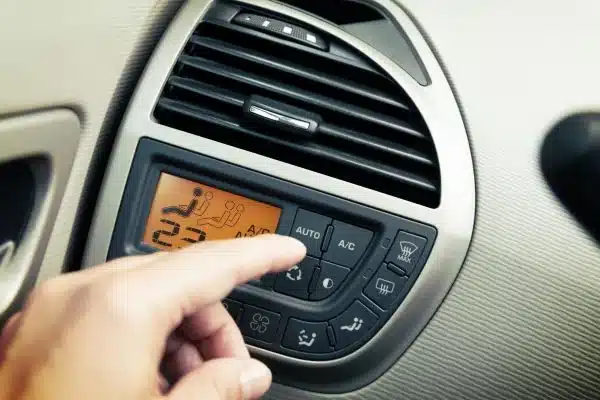If you are wondering, how to test car ac compressor with multimeter? Then, to test a car AC compressor with a multimeter,
“start by setting the multimeter to the “Ohms” or “Resistance” setting. Disconnect the electrical connector from the compressor and place the multimeter probes on the terminals. If the resistance reading is within the manufacturer’s specified range, the compressor is likely functioning correctly”.
What is a Car AC Compressor?
A car AC compressor is a crucial component of the vehicle’s air conditioning system. It is responsible for pressurizing and circulating refrigerant gas, which cools the air inside the car’s cabin. The engine’s serpentine belt drives the compressor.

It utilizes a piston or rotary mechanism to compress the refrigerant, enabling it to absorb heat from the cabin and release it outside the vehicle. By doing so, the AC compressor plays a vital role in maintaining comfortable temperature levels inside the car during hot weather.
How to Test Car AC Compressor with Multimeter? Step-by-step guideline
The car’s AC compressor plays a vital role in cooling your vehicle’s interior. If you suspect your AC compressor is not functioning properly, you can perform a simple test using a multimeter to check its electrical connections. This guide will walk you through the steps to to know how to test car ac compressor with multimeter.
Read more about How to Test Car Wiring with Multimeter
Note: Before performing any electrical tests, ensure your vehicle’s engine is turned off and the key is removed from the ignition. Additionally, take necessary precautions to prevent injury and damage to your vehicle.
Step 1: Gather the necessary tools and equipment
To perform the test, you will need the following items:
- A digital multimeter (preferably one with AC voltage measurement capabilities)
- Safety glasses
- Protective gloves
- The car’s service manual or wiring diagram (for reference)
Step 2: Locate the AC compressor

The AC compressor is typically found near the drive belts at the front of the engine. It is connected to the engine’s crankshaft and has a pulley on its front. Take note of its location for the following steps.
Step 3: Disconnect the electrical connector
Locate the electrical connector attached to the AC compressor. It is usually a single plug with multiple wires coming out of it. Carefully disconnect the connector by gently pulling it apart. Inspect the connector and wires for damage, corrosion, or loose connections.
Step 4: Set the multimeter to measure the AC voltage
Turn on the multimeter and set it to measure AC voltage. Depending on the multimeter model, this might involve selecting the appropriate setting or turning a dial to the AC voltage range. Refer to the multimeter’s user manual if you are unsure how to set it up.
Read more about7 Best DC Clamp Meter for Automotive
Step 5: Prepare for testing
Put on your safety glasses and protective gloves to protect yourself during the testing process. Safety precautions are essential when working around electrical components.
Step 6: Connect the multimeter to the electrical connector
With the electrical connector disconnected, identify the terminals inside the connector. You should see metal pins or sockets that correspond to the wires. Insert the multimeter probes into the appropriate terminals—one probe into one terminal and another probe into another terminal. Ensure a solid connection between the probes and terminals.
Step 7: Measure voltage across the terminals
Carefully reinsert the car key into the ignition and turn it to the “ON” position. Do not start the engine. This step is necessary to provide power to the AC system. Check your car’s service manual or wiring diagram to determine which terminal to use for the ground connection (commonly labeled as “GND” or “ground”).

Once everything is set up, observe the multimeter’s display. It should show the voltage reading across the terminals. If the compressor functions correctly, the multimeter should display a voltage within the expected range.
Step 8: Analyze the voltage reading
Compare the voltage reading displayed on the multimeter with the specifications outlined in your car’s service manual. If the voltage reading is significantly lower or higher than the expected range, it indicates a potential issue with the AC compressor or the electrical system.
Step 9: Perform additional tests (if necessary)
The electrical connections are likely in good condition if the voltage reading is within the expected range. However, if the reading is abnormal, it is recommended to consult a professional mechanic or refer to your car’s service manual for further troubleshooting steps. Hope so, now you know how to test car ac compressor with multimeter.
Tips to Take Care of Car AC Compressor
The car’s AC compressor is a critical component of the air conditioning system, responsible for cooling your vehicle’s interior. Proper care and maintenance of the AC compressor can ensure its longevity and optimal performance.
Regular Maintenance
Routine maintenance is crucial for the overall health of your car’s AC system, including the compressor. Follow these maintenance tips:
a. Change the AC filter: Regularly replace or clean the cabin air filter as the manufacturer recommends. A clogged filter can strain the AC system, including the compressor, and reduce efficiency.
b. Clean the condenser: The condenser, located in front of the radiator, can accumulate dirt, debris, and bugs. Periodically clean it using a soft brush or low-pressure air to ensure proper airflow and prevent overheating of the AC compressor.
c. Check the refrigerant level: Insufficient refrigerant can cause the AC compressor to work harder, potentially leading to damage. Have a professional check the refrigerant level regularly and add more if necessary.
d. Inspect the drive belt: The AC compressor is driven by a belt connected to the engine. Regularly inspect the drive belt for wear, cracking, or fraying. Replace it if it shows any signs of damage to prevent belt failure, which could affect the compressor’s operation.
Use the AC System Regularly

Using the AC system regularly, even during the colder months, helps maintain its functionality. Running the AC system for at least 10 minutes each month keeps the compressor lubricated and prevents seals from drying out. This practice also helps identify any potential issues early on.
Avoid Overworking the AC System
To prevent excessive strain on the AC compressor, follow these guidelines:
a. Gradual temperature adjustments: Avoid sudden and extreme temperature changes when setting the AC. Gradually adjust the temperature to avoid overworking the compressor.
b. Use recirculation mode: When the interior reaches a comfortable temperature, switch to recirculation mode to maintain the cool air and reduce the compressor workload.
c. Park in shaded areas: Whenever possible, park your vehicle in shaded areas or use sunshades to minimize heat buildup inside the car. This reduces the initial load on the AC system when starting the vehicle.
Be Mindful of Unusual Noises and Vibrations
Pay attention to any unusual noises or vibrations coming from the AC system. Unusual sounds like grinding, squealing, or rattling could indicate compressor issues or other AC system problems. If you notice any abnormal noises or vibrations, have the AC system inspected by a qualified technician.
Protect the Compressor from Physical Damage
Taking precautions to prevent physical damage to the AC compressor is essential. Here are a few tips:
a. Avoid impacts: Be cautious when parking or maneuvering your vehicle to prevent hitting curbs, speed bumps, or other objects that could damage the compressor or its components.
b. Clean debris from the engine bay: Regularly clean and remove any debris that may have accumulated around the AC compressor. Foreign objects can interfere with their operation or cause damage.
c. Be cautious when jump-starting the vehicle: When jump-starting a car, be mindful of the AC compressor and its components. Improperly connecting jumper cables can cause voltage spikes and damage electrical components, including the compressor.
Read more about5 Best Car Jump Starter with Air Compressor
Seek Professional Assistance
If you suspect any issues with your car’s AC compressor or the AC system, it is best to seek professional assistance. Certified technicians have the knowledge and expertise to diagnose and repair AC system problems effectively. Avoid attempting complex repairs unless you have the necessary skills and experience.
Frequently asked question
How do I know if my car’s AC compressor is good or bad?
To determine if your car’s AC compressor is functioning properly, look for signs such as insufficient cooling, strange noises, or leaks. Additionally, if the compressor fails to engage when the AC is turned on, it may be a sign of a faulty compressor. It is recommended to have a professional diagnose and repair the issue.
What is the voltage of the AC compressor?
The voltage of an AC compressor varies depending on the make and model of the vehicle. Most car AC compressors operate on a voltage range between 12 and 14 volts, supplied by the vehicle’s electrical system.
It’s important to consult the specific vehicle’s manual or seek professional advice to ensure accurate information regarding the AC compressor’s voltage.
Can low voltage damage the AC compressor?
Low voltage can potentially harm an AC compressor. Insufficient voltage can cause the compressor to work harder, increasing heat and potential damage. It may result in poor cooling performance, increased energy consumption, and even premature compressor failure.
Adequate and stable voltage is crucial for an AC compressor’s proper functioning and longevity.
Conclusion
How to test a car AC compressor with a multimeter involves setting the multimeter to the resistance setting, disconnecting the electrical connector from the compressor, and using the multimeter probes to measure the resistance across the compressor terminals.
If the resistance reading falls within the manufacturer’s specified range, it suggests that the compressor is functioning properly.
However, it’s important to note that this test only assesses the electrical continuity of the compressor and does not provide a comprehensive evaluation of its overall performance. I hope now you know how to test car ac compressor with multimeter.
